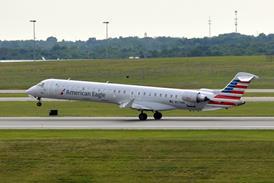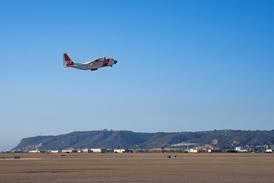TIM FURNISS / LONDON
Hyper-X lost in Pegasus failure NASA sets up an investigation board to determine why it had to destroy the booster carrying its hypersonic X-43A
A hybrid version of the Orbital Sciences (OSC) Pegasus XL booster carrying NASA's X-43A Hyper-X scramjet-powered research aircraft was deliberately destroyed over the Pacific Ocean, 51s after an air-launch from its Boeing B-52 mother ship on 2 June.
The Hyper-X flight, originating from the Dryden Flight Research Center, Edwards AFB, California, was aborted off the Californian coast after the vehicle shed debris about 8s after deployment and booster ignition and the craft "departed from controlled flight", says NASA. Video coverage indicates that a piece of tail-fin broke away, but this has to be confirmed. NASA established an interim incident investigation team shortly after the loss to collect and analyse data from the flight.
The Pegasus was to have fired its Orion 50S engine for 90s carrying the Hyper X payload to 2,900m (95,000ft) and Mach 7. The combination had already completed a 2h captive flight in April.
The MicroCraft-built Hyper X was to have fired its air-breathing supersonic-combustion ramjet (scramjet) for up to 10s at M7, beating the M6.7 record set by a modified X-15 rocket plane in 1967.
Two more X-43A flights are planned in the $137 million NASA programme. "We are disappointed, but we'll fix it and fly again successfully," said Vincent Rausch, Hyper-X project manager. The next flight had been set for late this year.
It was the sixth failure of a Pegasus vehicle in 32 flights since 1990. The aerodynamic forces created by the X-43A mounted on the nose of the hybrid Pegasus booster will be studied by the investigation board. The Pegasus normally flies with its payload encased in a shroud. The Hyper-X Pegasus shares some systems and technology, "but is not a satellite launch vehicle", says OSC.
Another Pegasus XL, due to launch the NASA High Energy Solar Spectroscopic Imager (HESSI) satellite on 7 June, was delayed to 12 June at the earliest after the accident. Hessi will transmit high-fidelity X-ray colour movies of the explosive solar flares in the sun's atmosphere.
Engineers are working to determine if there are any associated technical issues between the X-43A Pegasus failure and the fully fledged four-stage Pegasus XL to be used for the Hessi launch. This launch will use OSC's Lockheed L-1011 Stargazer deployed from Cape Canaveral.
Source: Flight International























